+検索条件
-Structure paper
| タイトル | A Native LH1-RC-HiPIP Supercomplex from an Extremophilic Phototroph. |
|---|---|
| ジャーナル・号・ページ | Commun Biol, Vol. 8, Issue 1, Page 42, Year 2025 |
| 掲載日 | 2025年1月11日 |
 著者 著者 | Kazutoshi Tani / Ryo Kanno / Kenji V P Nagashima / Mai Kawakami / Naho Hiwatashi / Kazuna Nakata / Sakiko Nagashima / Kazuhito Inoue / Shinichi Takaichi / Endang R Purba / Malgorzata Hall / Long-Jiang Yu / Michael T Madigan / Akira Mizoguchi / Bruno M Humbel / Yukihiro Kimura / Zheng-Yu Wang-Otomo /    |
| PubMed 要旨 | Halorhodospira (Hlr.) halophila strain BN9622 is an extremely halophilic and alkaliphilic purple phototrophic bacterium and has been widely used as a model for exploring the osmoadaptive and ...Halorhodospira (Hlr.) halophila strain BN9622 is an extremely halophilic and alkaliphilic purple phototrophic bacterium and has been widely used as a model for exploring the osmoadaptive and photosynthetic strategies employed by phototrophic extreme halophiles that enable them to thrive in hypersaline environments. Here we present the cryo-EM structures of (1) a unique native Hlr. halophila triple-complex formed from light-harvesting (LH1), the reaction center (RC), and high-potential iron-sulfur protein (HiPIP) at 2.44 Å resolution, and (2) a HiPIP-free LH1-RC complex at 2.64 Å resolution. Differing from the LH1 in the Hlr. halophila LH1-LH2 co-complex where LH1 encircles LH2, the RC-associated LH1 complex consists of 16 (rather than 18) αβ-subunits circularly surrounding the RC. These distinct forms of LH1 indicate that the number of subunits in a Hlr. halophila LH1 complex is flexible and its size is a function of the photocomplex it encircles. Like LH1 in the LH1-LH2 co-complex, the RC-associated LH1 complex also contained two forms of αβ-polypeptides and both dimeric and monomeric molecules of bacteriochlorophyll a. The majority of the isolated Hlr. halophila LH1-RC complexes contained the electron donor HiPIP bound to the surface of the RC cytochrome subunit near the heme-1 group. The bound HiPIP consisted of an N-terminal functional domain and a long C-terminal extension firmly attached to the cytochrome subunit. Despite overall highly negative surface-charge distributions for both the cytochrome subunit and HiPIP, the interface between the two proteins was relatively uncharged and neutral, forming a pathway for electron tunneling. The structure of the Hlr. halophila LH1-RC-HiPIP complex provides insights into the mechanism of light energy acquisition coupled with a long-distance electron donating process toward the charge separation site in a multi-extremophilic phototroph. |
 リンク リンク |  Commun Biol / Commun Biol /  PubMed:39799244 / PubMed:39799244 /  PubMed Central PubMed Central |
| 手法 | EM (単粒子) |
| 解像度 | 2.4 - 2.6 Å |
| 構造データ | EMDB-39836, PDB-8z82: EMDB-39837, PDB-8z83: |
| 化合物 |  ChemComp-HEC:  ChemComp-MG: 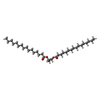 ChemComp-Z41:  ChemComp-PLM: 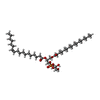 ChemComp-PGV: 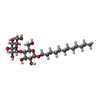 ChemComp-LMT:  ChemComp-BCL: 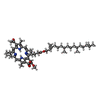 ChemComp-BPH:  ChemComp-UQ8: 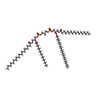 ChemComp-CDL:  ChemComp-FE:  ChemComp-MQ8:  ChemComp-CRT: 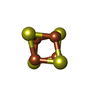 ChemComp-SF4: 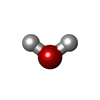 ChemComp-HOH: |
| 由来 |
|
 キーワード キーワード | PHOTOSYNTHESIS / LH1-RC |
 ムービー
ムービー コントローラー
コントローラー 構造ビューア
構造ビューア 万見文献について
万見文献について






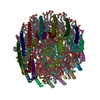
 halorhodospira halophila (紅色硫黄細菌)
halorhodospira halophila (紅色硫黄細菌)